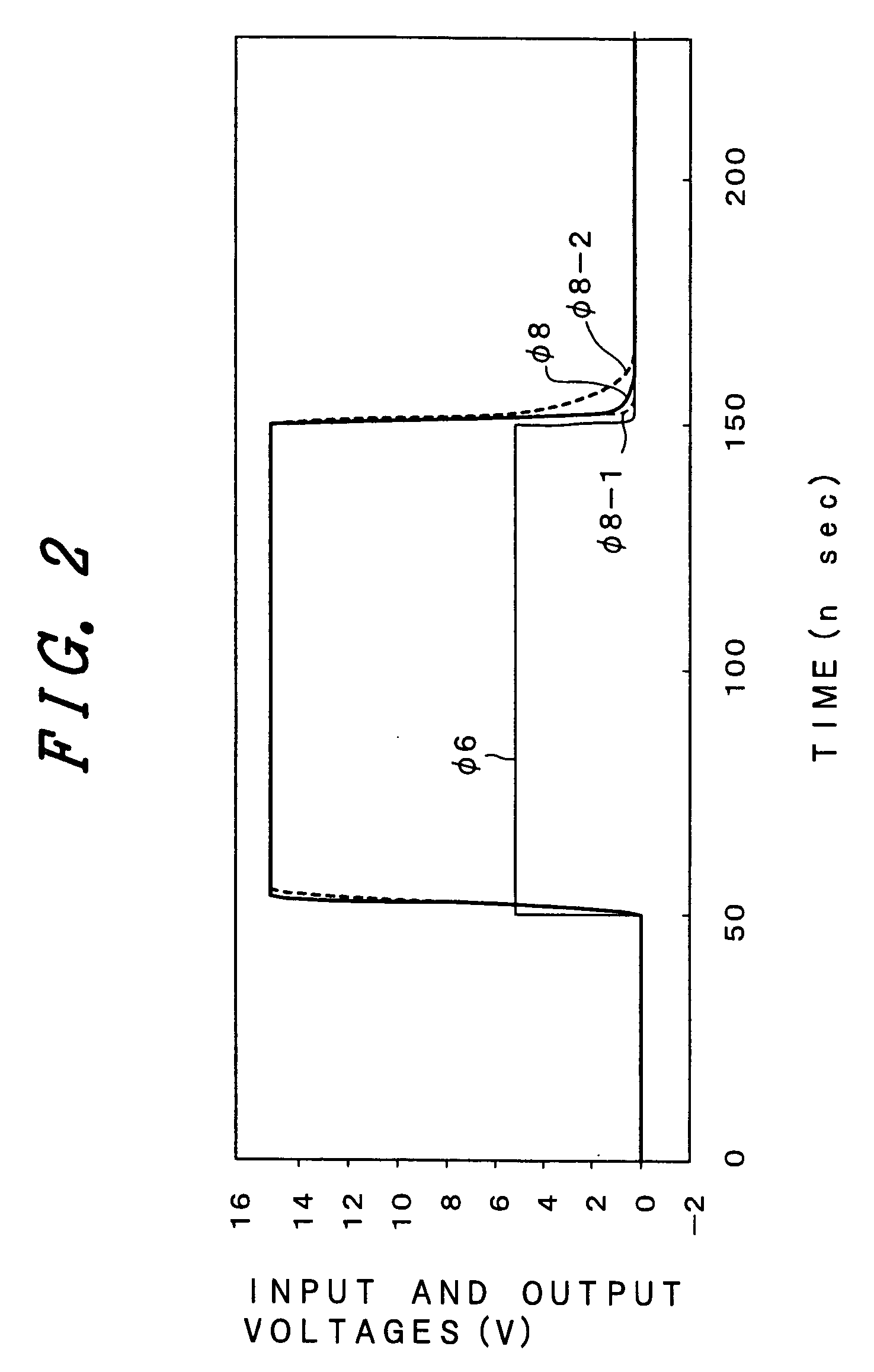Level converter circuit and a liquid crystal display device employing the same
a level converter and liquid crystal display technology, applied in logic circuit coupling/interface arrangement, pulse technique, instruments, etc., can solve the problems of many mos transistors, inability to obtain sufficient driving capability in a case, and level converter circuits that had many mos transistors, etc., to achieve high speed and stably irrespective
- Summary
- Abstract
- Description
- Claims
- Application Information
AI Technical Summary
Benefits of technology
Problems solved by technology
Method used
Image
Examples
embodiment 1
[0077]FIG. 1 is a circuit diagram representing a level converter circuit of Embodiment 1 of the present invention.
[0078] As shown in FIG. 1, the level converter circuit of this embodiment is formed by a total of transistors including two enhancement-mode p-channel polysilicon MOS transistors and two enhancement-mode n-channel polysilicon MOS transistors, and the level converter circuit has a first stage formed by PMOS M1 and NMOS M3 and a second stage formed by PMOS M2 and NMOS M4.
[0079] A source electrode of NMOS M3 of the first stage is connected to the reference voltage VSS (ground potential) and a gate electrode of NMOS M3 is supplied with an input signal φ6 from a input terminal VIN.
[0080] The input signal φ6 has an amplitude of VCC, or varies from a voltage higher than VCC to ground potential VSS.
[0081] A drain electrode of PMOS M1 is connected to a drain electrode of NMOS M3, and a source electrode and a gate electrode of PMOS M1 are connected to the high voltage VDD and ...
embodiment 2
[0103]FIG. 8 is a circuit diagram of a level converter circuit of Embodiment 2 of the present invention.
[0104] As shown in FIG. 8, the level converter circuit of this embodiment also uses a total of four enhancement-mode transistors including two p-channel polysilicon MOS transistors and two n-channel polysilicon MOS transistors, and has the first stage formed by PMOS M1 and NMOS M3 and the second stage formed by PMOS M2 and NMOS M4.
[0105] The level converter circuit of this embodiment differs from that of Embodiment 1, in that a source electrode of NMOS M3 of the first stage is supplied with the input signal φ6, a gate electrode of NMOS M3 is connected to the low voltage VCC, a source electrode of NMOS M4 of the second stage is connected to the reference voltage VSS and a gate electrode of NMOS M4 is supplied with the input signal φ6 from the input terminal VIN.
[0106] In the level converter circuit of this embodiment, when the input signal φ6 from the input terminal VIN is at th...
embodiment 3
[0114]FIG. 9 is a circuit diagram of a level converter circuit of Embodiment 3 of the present invention.
[0115] As shown in FIG. 9, the level converter circuit of this embodiment also uses a total of four enhancement-mode transistors including two p-channel polysilicon-MOS transistors and two n-channel polysilicon MOS transistors, and has the first stage formed by PMOS M1 and NMOS M3 and the second stage formed by PMOS M2 and NMOS M4.
[0116] The level converter circuit of this embodiment differs from that of Embodiment 1, in that a gate electrode of PMOS M1 of the first stage is connected to a drain electrode (i.e., the output terminal VOUT) of PMOS N2 of the second stage.
[0117] In the level converter circuit of this embodiment, when the input signal φ6 from the input terminal VIN is at the H level, NMOS M3 is ON, PMOS M1 is OFF, NMOS M4 is OFF, PMOS M2 is ON, and therefore the output terminal VOUT outputs the high voltage VDD.
[0118] Next, when the input signal oh 6 is at the L le...
PUM
| Property | Measurement | Unit |
|---|---|---|
| softening temperature | aaaaa | aaaaa |
| threshold voltage | aaaaa | aaaaa |
| threshold voltage | aaaaa | aaaaa |
Abstract
Description
Claims
Application Information
 Login to View More
Login to View More - R&D
- Intellectual Property
- Life Sciences
- Materials
- Tech Scout
- Unparalleled Data Quality
- Higher Quality Content
- 60% Fewer Hallucinations
Browse by: Latest US Patents, China's latest patents, Technical Efficacy Thesaurus, Application Domain, Technology Topic, Popular Technical Reports.
© 2025 PatSnap. All rights reserved.Legal|Privacy policy|Modern Slavery Act Transparency Statement|Sitemap|About US| Contact US: help@patsnap.com



